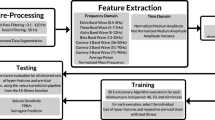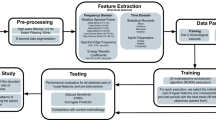A general-purpose, systematic algorithm is presented, consisting of a genetic programming module and a k-nearest neighbor classifier to automatically create artificial features—computer-crafted features possibly without a known physical meaning—directly from the reconstructed state-space trajectory of intracranial EEG signals that reveal predictive patterns of epileptic seizures. The algorithm was evaluated with IEEG data from seven patients, with prediction defined over a horizon of 1–5 min before unequivocal electrographic onset. A total of 59 baseline epochs (nonseizures) and 55 preictal epochs (preseizures) were used for validation purposes. Among the results, it is shown that 12 seizures out of 55 were missed while four baseline epochs were misclassified, yielding 79% sensitivity and 93% specificity.
















Similar content being viewed by others
REFERENCES
D'Alessandro, M. The Utility of Intracranial EEG Feature and Channel Synergy for Evaluating the Spatial and Temporal Behavior of Seizure Precursors, PhD Dissertation, Georgia Institute of Technology, Atlanta, 2001.
D'Alessandro, M., R. Esteller, G. Vachtsevanos, A. Hinson, J. Echauz, and B. Litt. Epileptic seizures prediction using hybrid feature selection over multiple intracranial EEG electrode contacts: A report of four patients. IEEE Trans. Biomed. Eng. 50(5):603–615, 2003.
Duda, R., P. Hart, and D. Stork. Pattern Classification, 2nd ed. New York: Wiley, 2001.
Echauz, J. Wavelet Neural Networks for EEG Modeling and Classification, PhD Dissertation, Georgia Institute of Technology, August 1995.
Elger, C. E., and K. Lehnertz. Seizure prediction by non-linear time series analysis of brain electrical activity. Eur. J. Neurosci. 10:786–789, 1998.
Firpi, H. Genetically Found, Neurally Computed Artificial Features with Applications to Epileptic Seizure Detection and Prediction, Master's Thesis, University of Puerto Rico-Mayagüez, 2001.
Firpi, H. On Prediction and Detection of Epileptic Seizures by Means of Genetic Programming Artificial Features, PhD Dissertation, Michigan State University, 2005.
Gilmore, R., and M. Lefranc. The Topology of Chaos: Alice in the Stretch and Squeezeland. New York: Wiley, 2002.
Haupt, R. L., and S. E. Haupt. Practical Genetic Algorithms. New York: Wiley, 1998.
Iasemidis, L. Epileptic seizure prediction and control. IEEE Trans. Biomed. Eng. 50(5):549–559, 2003.
Iasemidis, L., D.-S. Shiau, W. Chaovalitwongse, J. C. Sackellares, P. M. Pardalos, J. C. Principe, P. R. Carney, A. P. Prasad, B. Veeramani, and K. Tsakalis. Adaptive epileptic seizure prediction system. IEEE Trans. Biomed. Eng. 50(5):616–627, 2003.
Jansen, B. H. Quantitative analysis of electroencephalograms: Is there chaos in the future? Int. J. Biomed. Comput. 27:95–123, 1991.
Jia, W., N. Kong, F. Li, X. Gao, S. Gao, G. Zhang, Y. Wang, and F. Yang. An epileptic seizure prediction algorithm based on second-order complexity measure. Physiol. Meas. 26:609–625, 2005.
Koza, J. R. Genetic Programming: On Programming of Computers by Means of Natural Selection. Cambridge, MA: MIT Press, 1992.
Lee, S. A., D. D. Spencer, and S. S. Spencer. Intracranial EEG seizure-onset patterns in neocortical epilepsy. Epilepsia 41(3):297–307, 2000.
Lehnertz, K., and C. E. Elger. Spatio-temporal dynamics of the primary epileptogenic area in temporal lobe epilepsy characterized by neuronal complexity loss. Electroencephalogr Clin Neurophysiol 95:108–117.
Lehnertz, K., and B. Litt. The First International Collaborative Workshop on Seizure Prediction: Summary and data description. Clin. Neurophysiol. 116(3):493–505, 2005.
Litt, B., R. Esteller, J. Echauz, M. D'Alessandro, R. Shor, T. Henry, P. Pennell, C. Epstein, R. Bakay, M. Dichter, and G. Vachtsevanos. Epileptic seizures may begin hours in advance of clinical seizures: A report of five patients. Neuron 29(4):51–64, 2001.
Martinerie, J., C. Adam, M. le van Quyen, M. Baulac, S. Clemenceau, B. Renault, and F. J. Valera.. Epileptic seizures can be anticipated by non-linear analysis. Nat. Med. 4:1176–1176, 1998.
Niederhoefer, C., F. Gollas, A. Chernihovskyi, K. Lehnertz, and R. Tetzlaff. Detection of seizure precursors in the EEG with cellular neural networks. Epilepsia 45(7):245, 2004 (abstract).
Orfanidis, S. J. Optimum Signal Processing: An Introduction, 2nd ed. Englewood Cliffs, NJ: Prentice-Hall, 1996.
Petrosian, A., D. Prokhorov, R. Homan, R. Dashieff, and D. Wunch. Recurrent neural network based prediction of epileptic seizures in intra- and extracranial EEG. Neurocomputing 30:201–218, 2000.
Pritchard, W. S., and D. W. Duke. Measuring chaos in the brain: A tutorial review of nonlinear dynamical EEG analysis. Brain Cogn 27(3):353–397, 1995.
Sowa, R., F. Mormann, A. Chernihovskyi, C. Niederhoefer, R. Tetzlaff, C. Elger, and K. Lehnertz. Seizure prediction: Measuring EEG phase synchronization with cellular neural networks. Epilepsia 45(7):244, 2004 (abstract).
Sprott, J. C. Chaos and Time-Series Analysis. New York: Oxford University Press, 2003.
Takens, F. Detecting strange attractors in turbulence. In: Dynamical Systems and Turbulence, Warwick 1980 Lecture Notes in Mathematics 898. Berlin: Springer-Verlag, 1981, pp. 336–381.
Author information
Authors and Affiliations
Corresponding author
APPENDIX
APPENDIX
This appendix shows the point-basis results for all the epochs available evaluated with the GPAF algorithm, for each patient. Small letters denote baseline epochs, whereas capital letters denote preictal epochs.
Epoch | GPAF |
|---|---|
Patient A: Point-basis classification results for patient A | |
b | 61.54 |
c | 57.86 |
d | 57.19 |
B | 80.33 |
C | 69.23 |
D | 73.91 |
Overall | 66.68% |
Patient B: Point-basis classification results for patient B | |
b | 82.61 |
c | 89.63 |
d | 86.96 |
e | 88.29 |
f | 81.61 |
g | 77.26 |
B | 85.62 |
C | 66.56 |
D | 94.65 |
E | 53.17 |
Overall | 80.64% |
Epoch | GPAF |
|---|---|
Patient C: Point-basis classification results for patient C | |
b | 100 |
c | 100 |
d | 40.8 |
e | 70.9 |
f | 99.0 |
g | 100 |
h | 100 |
i | 87.63 |
j | 100 |
k | 97.32 |
A | 100 |
B | 99.66 |
C | 87.63 |
E | 81.61 |
F | 99.0 |
G | 97.99 |
H | 96.99 |
I | 99.0 |
J | 96.66 |
K | 100 |
Overall | 92.71% |
Patient D: Point-basis classification results for patient D | |
a | 96.66 |
b | 96.33 |
d | 47.16 |
f | 96.65 |
g | 91.30 |
h | 90.97 |
i | 45.82 |
j | 20.74 |
k | 51.84 |
l | 88.63 |
B | 0.33 |
C | 74.92 |
D | 8.03 |
E | 53.18 |
F | 86.29 |
G | 77.93 |
H | 86.96 |
I | 17.07 |
J | 86.29 |
K | 84.95 |
Overall | 65.10% |
Patient E: Point-basis classification results for patient E | |
a | 26.85 |
b | 72.82 |
c | 100.0 |
d | 100.0 |
e | 70.47 |
f | 100.0 |
h | 100.0 |
i | 100.0 |
j | 57.05 |
k | 100.0 |
l | 100.0 |
m | 100.0 |
n | 100.0 |
o | 53.69 |
p | 74.5 |
Epoch | GPAF |
|---|---|
A | 79.53 |
B | 93.29 |
C | 48.99 |
D | 92.95 |
E | 94.63 |
F | 92.28 |
G | 94.3 |
H | 94.97 |
I | 17.11 |
J | 97.32 |
K | 97.32 |
L | 98.32 |
M | 49.66 |
N | 78.52 |
O | 9.4 |
Overall | 79.8% |
Patient F: Point-basis classification results for patient F | |
b | 83.56 |
c | 86.58 |
d | 66.56 |
e | 100.0 |
f | 100.0 |
g | 100.0 |
h | 100.0 |
B | 97.99 |
C | 99.33 |
D | 100.0 |
E | 100.0 |
F | 99.33 |
Overall | 94.45% |
Patient G: Point-basis classification results for patient G | |
b | 60.2 |
c | 9.03 |
d | 26.76 |
e | 71.57 |
f | 59.2 |
g | 79.26 |
i | 94.65 |
j | 96.66 |
B | 29.77 |
C | 79.6 |
D | 90.97 |
E | 84.28 |
F | 51.17 |
G | 90.64 |
H | 89.97 |
I | 51.51 |
Overall | 66.58% |
Rights and permissions
About this article
Cite this article
Firpi, H., Goodman, E. & Echauz, J. On Prediction of Epileptic Seizures by Means of Genetic Programming Artificial Features. Ann Biomed Eng 34, 515–529 (2006). https://doi.org/10.1007/s10439-005-9039-7
Received:
Accepted:
Published:
Issue Date:
DOI: https://doi.org/10.1007/s10439-005-9039-7




